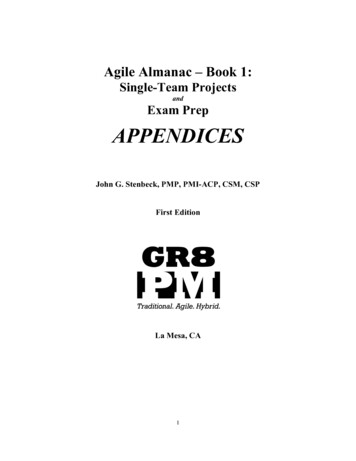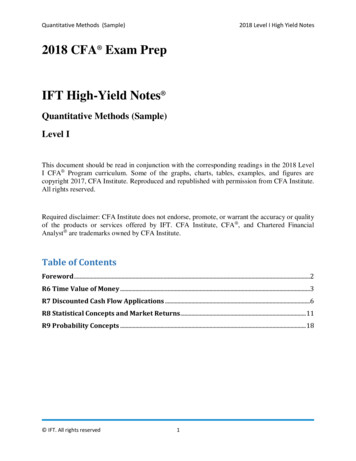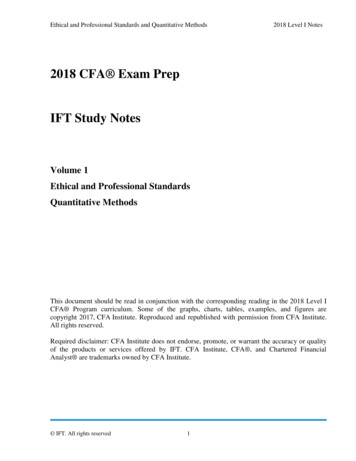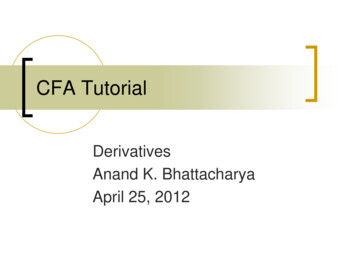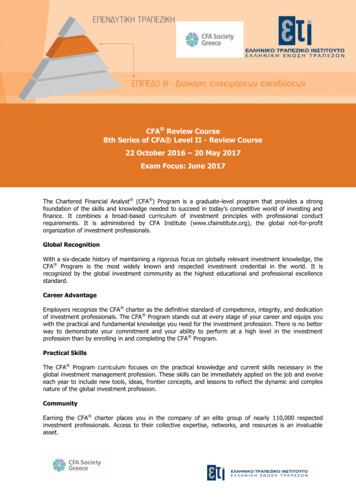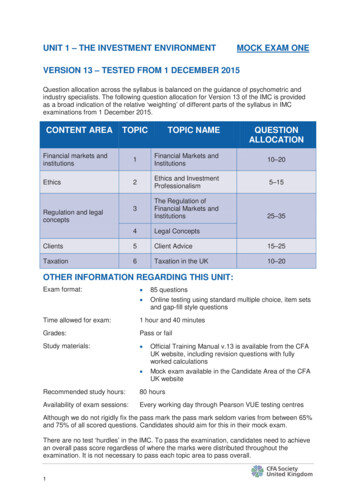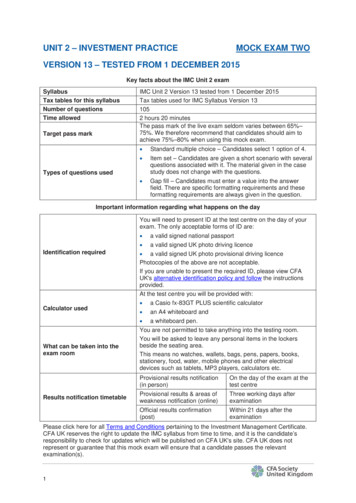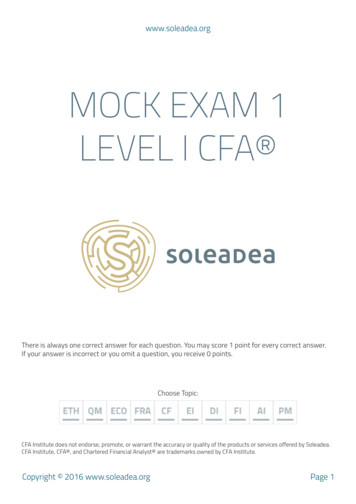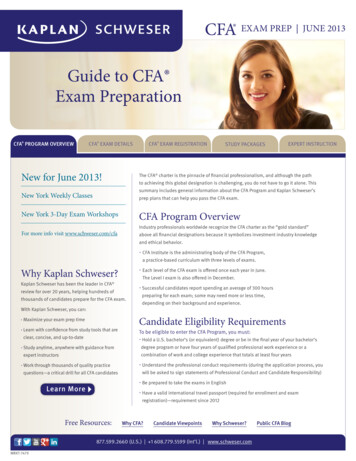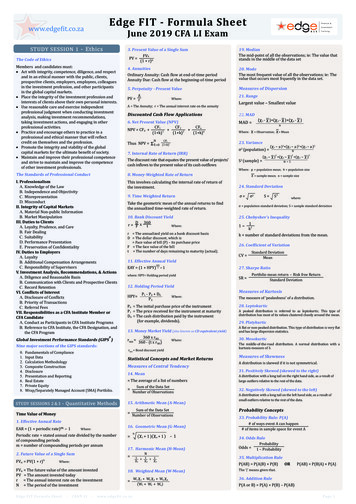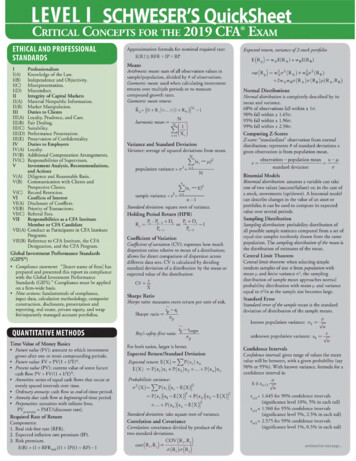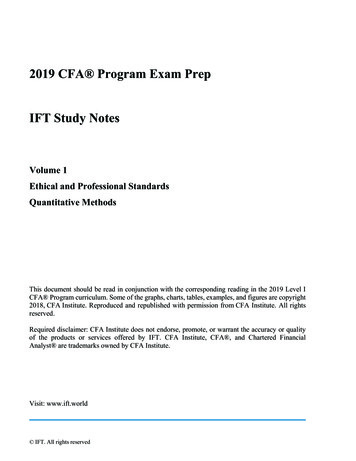
Transcription
2019 CFA Program Exam PrepIFT Study NotesVolume 1Ethical and Professional StandardsQuantitative MethodsThis document should be read in conjunction with the corresponding reading in the 2019 Level ICFA Program curriculum. Some of the graphs, charts, tables, examples, and figures are copyright2018, CFA Institute. Reproduced and republished with permission from CFA Institute. All rightsreserved.Required disclaimer: CFA Institute does not endorse, promote, or warrant the accuracy or qualityof the products or services offered by IFT. CFA Institute, CFA , and Chartered FinancialAnalyst are trademarks owned by CFA Institute.Visit: www.ift.world IFT. All rights reserved
Ethical and Professional Standards and Quantitative Methods2019 Level I NotesCopyright 2018 IFT.All rights reserved. This book or any portion thereof may not be reproduced or used in any mannerwhatsoever without the express written permission of the publisher except for the use of briefquotations in a book review.Published in 2018 by IFTErrata information can be found at: https://ift.world/errataISBN IFT. All rights reserved1
Ethical and Professional Standards and Quantitative Methods2019 Level I NotesPrefaceIFT has helped thousands of candidates successfully prepare for all three levels of the CFA Program exam since 2011. IFT provides a complete learning system and preparationstrategy. All IFT materials remain close to the CFA Program curriculum. We help studentsdevelop a thorough understanding of fundamental concepts via active learning and exampractice. IFT Study Notes and Detailed Lecture Videos help you understand and retaincurriculum concepts. Practice using IFT Quizzes and Question Bank is essential to test yourgrasp of the materials. Close to the exam date, IFT High‐Yield Videos, High‐Yield Notes andHigh‐Yield Question Bank along with mock exams will help you achieve success.Recommended Exam Preparation StrategyThe CFA Program curriculum is important and all IFT products focus on its core concepts.Start your preparation as early as possible. Give yourself at least 6 months for a thoroughpreparation and begin by making a schedule. For each reading in the curriculum, you shoulddo the following:1. Read IFT Study Notes for each reading. IFT recommends starting with QuantitativeMethods. Do the questions at the end of each reading to help reinforce and retain theconcepts.2. If you need additional help, watch IFT Detailed Video Lectures. Pause, rewind, andreview where you need more time to understand. Print out the slides and take yourown notes as you are watching.3. Read the examples in the curriculum (also known as blue‐box examples) and do themon your own. Watch IFT example videos to further grasp concepts and practice them.4. Do the practice problems from the curriculum at the end of each reading.5. Do the IFT Question Bank for that reading.6. After doing all the readings in a topic, take the IFT Topic Exam.7. Two months prior to the exam or when you have done the above steps for everyreading, you should start your revision using the IFT High‐Yield Course.8. One month before the exam you should attempt the CFA Institute and IFT mockexams. These should be done in a manner to replicate your real exam experience.Below are some further details about IFT resources for Level I exam preparation.IFT Detailed Lecture Videos: These videos closely follow the curriculum and cover allsections and learning outcomes of a reading. Lectures slides are available in PDF format. Youcan print these slides and make notes on them as you follow the video lecture. This practiceis part of active learning whereby you make notes and carefully follow examples. The totalduration of the videos is over 70 hours. IFT. All rights reserved2
Ethical and Professional Standards and Quantitative Methods2019 Level I NotesIFT Study Notes: IFT Study Notes are closely aligned with the Detailed Lecture Videos andpresent information in an easily understandable manner. The most important points,formulas, and examples are highlighted and explained. Reading the notes helps reinforceyour understanding and grasp of concepts. Both notes and videos are organized to match thecurriculum (reading number/section number) so you can stay close to it.IFT Example Videos: These videos present examples and their worked solutions. They aresimilar but not exactly the same as the blue‐box examples from the curriculum. Theunderlying concepts are the same, but the numbers might be different. The total duration ofthese videos is approximately 30 hours.IFT Question Bank: Practicing lots of exam‐like questions (and solving them correctly!) isthe key to your exam success. The IFT Question Bank has over 3,000 questions with detailedexplanations. Questions are available for every learning outcome, reading, and topic. Thequestions are arranged in tests of 20‐25 questions each.IFT Topic Exams: These will test your preparation at the topic level. A topic exam should betaken after you have studied all readings of a given topic and have completed practicequestions for each reading. This is an essential step in preparing for the exam.IFT Mock Exams: IFT has full length mock exams to get you exam‐ready. Answers anddetailed explanations are provided for self‐grading.IFT High‐Yield Notes: IFT High‐Yield Notes are based on Pareto’s 80‐20 rule according towhich 80% of the exam questions are likely to be based on 20% of the curriculum. Hencethese notes focus on the 20% material which is most testable. They summarize the mostimportant concepts from each reading in two to five pages.IFT High‐Yield Videos: These are video lectures based on the High‐Yield Notes. Eachreading is covered in 10 to 20 minutes. Total duration is approximately 15 hours.IFT High‐Yield Q‐Bank: The IFT High‐Yield Q‐Bank has between 600 and 700 questionscovering concepts which are most likely to show up on the exam. All learning outcomes arecovered and there is minimum overlap of the questions.Q&A with IFT: When are you are stuck on a concept, example, or question, then the ‘Q&Awith IFT’ service is where to turn to. Submit your query, and an IFT instructor will providean individualized response.Finally, be sure to follow IFT on social media and visit www.ift.world for my latest blogs andstudy advice. Do reach out to the IFT team if you need any help or have questions.I wish you all the best in your studies.Warm regards,Arif Irfanullah, CFA IFT. All rights reserved3
Ethical and Professional Standards and Quantitative Methods2019 Level I NotesTable of ContentsR01 Ethics and Trust in the Investment Profession . 81. Introduction .82. Ethics .83. Ethics and Professionalism .94. Challenges to Ethical Conduct .95. The Importance of Ethical Conduct in the Investment Industry .106. Ethical vs. Legal Standards .117. Ethical Decision‐Making Framework .12Summary.14Practice Questions .16R02 Code of Ethics and Standards of Professional Conduct .19Introduction .19CFA Institute Professional Conduct Program .19Code of Ethics .20Standards of Professional Conduct .20Summary.25R03 Guidance for Standards I‐VII.26Introduction .26Standard I: Professionalism .26Standard II: Integrity of Capital Markets .32Standard III: Duties to Clients .34Standard IV: Duties to Employers .40Standard V: Investment Analysis, Recommendations, and Actions .44Standard VI: Conflicts of Interest.48Standard VII: Responsibilities as a CFA Institute Member or CFA Candidate .52Summary.55Practice Questions .57R04 Introduction to GIPS . 66Introduction .661. Why Were the GIPS Standards Created? .662. Who Can Claim Compliance?.663. Who Benefits from Compliance? .674. Composites .675. Verification .686. The Structure of the GIPS Standards .68 IFT. All rights reserved4
Ethical and Professional Standards and Quantitative Methods2019 Level I NotesSummary.69Practice Questions .70R05 The GIPS Standard. 72Introduction .72Goals of the GIPS Executive Committee .72Key Features of the GIPS Standards .72Historical Performance Record .73Compliance .73Implementing a Global Standard .74Nine Major Sections of the GIPS Standards .74Sample Presentation .78Summary.81Practice Questions .82R06 Time Value of Money . 84Introductory Note .841. Introduction .842. Interest Rates: Interpretation .853. The Future Value of a Single Cash Flow .874. The Future Value of a Series of Cash Flows .925. The Present Value of a Single Cash Flow .946. The Present Value of a Series of Cash Flows.977. Solving for Rates, Number of Periods, or Size of Annuity Payments .103Summary.106Practice Questions .109R07 Discounted Cash Flow Applications .1131. Introduction .1132. Net Present Value and Internal Rate of Return .1133. Portfolio Return Measurement .1174. Money Market Yields .120Summary.125Practice Questions .127R08 Statistical Concepts and Market Return .1311. Introduction .1312. Some Fundamental Concepts .1313. Summarizing Data Using Frequency Distributions .1324. The Graphic Presentation of Data.1335. Measures of Central Tendency.135 IFT. All rights reserved5
Ethical and Professional Standards and Quantitative Methods2019 Level I Notes6. Other Measures of Location: Quantiles .1387. Measures of Dispersion .1398. Symmetry and Skewness in Return Distributions .1439. Kurtosis in Return Distributions .14410. Using Geometric and Arithmetic Means .145Summary.146Practice Questions .150R09 Probability Concepts . 1571. Introduction .1572. Probability, Expected Value, and Variance .1573. Portfolio Expected Return and Variance of Return.1634. Topics in Probability.165Summary.170Practice Questions .174R10 Common Probability Distributions. 1791. Introduction .1792. Discrete Random Variables .1793. Continuous Random Variables .1834. Monte Carlo Simulation .188Summary.189Practice Questions .193R11 Sampling and Estimation . 1981. Introduction .1982. Sampling .1983. Distribution of the Sample Mean .2004. Point and Interval Estimates of the Population Mean .2015. More on Sampling .206Summary.208Practice Questions .211R12 Hypothesis Testing . 2161. Introduction .2162. Hypothesis Testing .2163. Hypothesis Tests Concerning the Mean .2214. Hypothesis Tests Concerning Variance.2255. Other Issues: Nonparametric Inference .229Summary.230Practice Questions .234 IFT. All rights reserved6
Ethical and Professional Standards and Quantitative Methods2019 Level I NotesR13 Technical Analysis.2381. Introduction .2382. Technical Analysis: Definition and Scope .2383. Technical Analysis Tools .2394. Elliot Wave Theory .2525. Inter‐market Analysis .253Summary.254Practice Questions .258 IFT. All rights reserved7
R01 Ethics and Trust in the Investment Profession2019 Level I NotesR01 Ethics and Trust in the Investment Profession1. IntroductionTo illustrate the importance of ethical behavior, the curriculum cites the example of ananalyst’s action at a financial services firm. The research department at the firm isresponsible for making investment recommendations to clients after sound analysis andvaluation of companies. One of the analysts at the firm misrepresents facts in his report withthe objective of pleasing the management of the subject company. He hoped this would leadto financial benefits for his employer and himself. Clients who acted on the recommendationincur heavy losses and spread a negative word on several online forums about the firm. Thiseventually affects the reputation of the firm, forcing it to downsize and many employees losetheir job. This example illustrates how one member’s unethical actions have a spiralingeffect on the firm and other employees for no fault of theirs.The foundation of the investment management industry is trust. The top three attributes ofan investment management firm are as follows: Has transparent and open business practices. Takes responsible actions to address an issue or crisis. Has ethical business practices.Ethical behavior is not just about adhering to the law, rules, and regulations. It is aboutidentifying potential conflicts and acting righteously in situations where there are no statedrules.2. EthicsThe word ethics comes from the Greek word “ethos” meaning character, guiding beliefs, orideals. There are several definitions of ethics all of which essentially convey the samemeaning.Ethics can be described as a set of moral principles and rules of conduct that provideguidance for our behavior. Ethical principles define what is good, acceptable behavior andwhat is forbidden or unacceptable behavior. Examples of ethical principles include honesty,diligence, justice, being open about the costs involved in an investment, fairness, and respectfor the rights of others.Another definition of ethical conduct is behavior that balances one’s own interest with thedirect and indirect consequences of the behavior on others.Instructor’s Note:The ‘others’ are often referred to as stakeholders, i.e. groups of people or individuals whoare directly or indirectly impacted by our decisions.Specific communities formally define the rules for acceptable and forbidden behavior into awritten set of principles called the code of conduct. Professional associations, universities IFT. All rights reserved8
R01 Ethics and Trust in the Investment Profession2019 Level I Notesand companies often adopt a code of ethics and expect their members to adhere to thoserules, at the very least. The members may choose to display higher standards of behaviorthan what is stipulated in the code of ethics.Some communities may also expand on their code of ethics and adopt explicit rules orstandards that identify specific behaviors required of community members. Thesestandards of conduct serve as a benchmark of the minimally acceptable behavior expectedfrom members of a community.CFA Institute is an example of a community that has laid down a code of ethics and standardsof conduct for its members and candidates to follow. The set of principles comprising theCode of Ethics and Standards of Professional Conduct is clearly documented in the CFAInstitute Standards of Practice Handbook.Members and candidates are required to pledge their commitment to abide by the Code andStandards each year. They are also required to disclose any violations of the Code andStandards in their Professional Conduct Statement each year. Members who violate the Codeand Standards face disciplinary action.3. Ethics and ProfessionalismAn occupation can be divided into: job, vocation, and profession. A job is work one does toearn a livelihood, or earn money. A vocation is a job that one is passionate about doing; onederives a sense of satisfaction or meaning from it, as it is his/her calling. A profession is theultimate evolution of occupation. It:1) requires specialized training and skills,2) is based on service to others, and3) is practiced by members who share and adhere to a common code of ethics.Professionals use their acquired skills to serve their clients. Clients differ from customers. Acustomer is one who engages in a single or a series of transactions to buy a good or service.This relationship is transactional in nature. A client, on the other hand, uses the services of aprofessional on an ongoing basis, for a fee. The basis of this relationship is trust and theclient’s interests take priority over personal or employer’s interests.In any given profession, the code of ethics openly communicates the established principles ofthe profession and how its members are expected to behave. It helps in building publicconfidence that members of the profession will use their skills and knowledge for the benefitof their clients.4. Challenges to Ethical ConductSome of the challenges to ethical conduct include the following:Overestimating one’s morality: People believe they are more ethical than they actually are.This overconfidence in themselves can sometimes lead to faulty decision‐making. It is often IFT. All rights reserved9
R01 Ethics and Trust in the Investment Profession2019 Level I Notesseen that emotions cloud rational thinking, prompting one to make decisions that may not bethe most ethical choice.Situational influences: These are external factors such as cultural, social, andenvironmental factors that influence one’s thinking, behavior, and decision‐making. Some ofthe common situational influences are: Money and prestige: Both money and prestige push people to act in their own self‐interests and take actions that are less ethical. The promise of a large financial bonus or apromotion, can impact people’s thinking ability and cause them to act in their own short‐term interests and ignore the long‐term consequences of their actions. Loyalty to employer, employee, and colleagues: Loyalty can have both positive andnegative effects. For instance, some colleagues may encourage you to behave moreethically and enroll in the CFA Program to advance your career. On the other hand,colleagues who do not adhere to the Code and Standards may encourage you to simplyact in accordance with the local law, even though it may fall short of ethical conduct. Compliance culture: A strong compliance policy is important for ethical decision‐making;however, processes focused solely on compliance oversimplify decision‐making and donot help the larger cause. The curriculum cites the example of Enron, which engaged intransactions with third‐party entities where Enron’s CFO, Andrew Fastow, had apersonal interest. In keeping with the spirit of compliance, Fastow sought approvals fromthe board of directors for all the proposed transactions with Enron. The board failed tosee beyond the compliance requirements and did not question Fastow’s vested intereststhat were not aligned with that of Enron’s shareholders.5. The Importance of Ethical Conduct in the Investment IndustryThe investment industry connects two parties: investors and borrowers. Borrowers arethose who are in need of capital to fund their long‐term goals or their regular operations.Long‐term goals may include building schools, factories, bridges, etc. Investors are thosewho supply capital and seek a return. The investment industry bridges th
The CFA Program curriculum is important and all IFT products focus on its core concepts. Start your preparation as early as possible. Give yourself at least 6 months for a thorough preparation and begin by making a schedule. For each reading in the curriculum, you should do the following:
